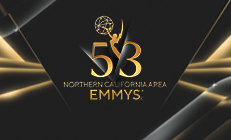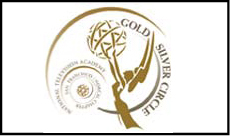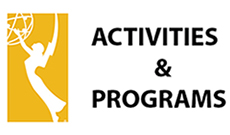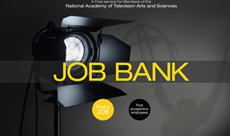 “Captain Satellite & Co-Pilot 60 Years Later.” Forrest Patton and Bob March have been friends for years. The right photo was taken in Nov. of 2019, the last time Forrest visited Bob. Forrest us a former Governor and owner of Kaleidosound. He wrote the story below for the February 1999 Off Camera.
“Captain Satellite & Co-Pilot 60 Years Later.” Forrest Patton and Bob March have been friends for years. The right photo was taken in Nov. of 2019, the last time Forrest visited Bob. Forrest us a former Governor and owner of Kaleidosound. He wrote the story below for the February 1999 Off Camera.
By Forrest Patton
During the late 1950’s to the late 1960’s, locally produced children’s television programs seemed to flourish in the Bay Area. Names like Skipper Sedley, Miss Nancy, Captain Fortune, Marshal J, Mayor Art, and Charley and Humphrey still remind many baby boomers of a very special era in their lives. They were our heroes, and, at the same time, would inform us of many new toys or food products that we would certainly “tell Mom to buy.”
 One program, though, seemed to go “beyond the call of duty” in its format and presentation to its young viewers. ‘Captain Satellite‘ had to be one of the most imaginative and innovative kid’s shows of that period. By today’s standards, it contained everything a good children’s program should have: it was entertaining, it educated, it encouraged audience participation, and its host was believable. Back then, it also sold lots of products.
One program, though, seemed to go “beyond the call of duty” in its format and presentation to its young viewers. ‘Captain Satellite‘ had to be one of the most imaginative and innovative kid’s shows of that period. By today’s standards, it contained everything a good children’s program should have: it was entertaining, it educated, it encouraged audience participation, and its host was believable. Back then, it also sold lots of products.
Bob March was the program’s creator and performer. When KTVU, Channel 2 went on the air in March 1958, Bob approached the late William Pabst (KTVU’s founder) with an idea for a children’s program he had created for a television station in Bakersfield, California. The program was called ‘Captain Jet’. When Pabst gave the go-ahead, Bob brought his character to the Bay Area with the new title ‘Captain Satellite.’ The Russians had just put Sputnik into orbit, so the name “Satellite” was very appropriate.
The original STARFINDER set was built on the stage of the Paris Theater of the old Moose Hall in Oakland. Everything from pie plates to garden hoses and parts of a dismantled pinball machine was used to create the interior. Kids did not appear on the program in the beginning. This had to do with a lack of space on the set (which only contained a control panel, a few discs and panels on the wall, and a sliding “spacelock” used for a daily contest). This would change very shortly when the new studios on Washington Street would open in 1959. Before the move to the new studios, Bob created and promoted a 45-rpm record showcasing the Captain with all of the familiar sound effects, and an adventure, taking listeners to the dark side of the moon. ‘Blast Off With Captain Satellite’ is a true collector’s item.
During those early programs, his robot companion, Rupert, joined the Captain. Bob, along with KTVU’s Dick Weise and Pete Felice designed the costume. Another interesting character was the “disembodied” Sir Hiccup. Gene Hayes performed that character. By taking a black marking pen and drawing hair, two eyes and a nose on Hayes’ chin, a camera (shooting an extreme close-up) was inverted. This resulted in the bottom of the chin becoming the top of the head with the mouth, lips and tongue creating some rather interesting facial expressions!
When the Washington Street studios opened in 1959 (known as #1 Jack London Square), the station wanted children to be able to appear on the show. In order to do that, a very elaborate set was designed and built by KTVU’s construction department under the direction of Bob and the late Ian Zellick. The STARFINDER II was born and took up the entire back wall of Studio B. The new set came complete with salvaged equipment taken from jets and other military equipment, a control panel, an electronic brain, motion controlled sliding doors, a large circular viewing monitor, and an exterior star field.
 BOB MARCH describes the show as “very low tech.” Although it was shot using only two studio cameras, it was amazing to see what could be produced at that time. Using some clever audio and video tricks, the daily opening of the program was always a high light. The Captain, (or one of the lucky “co pilots”), would sit at the control panel and “buzz” the tower requesting permission for launch. The director would then cut to some NASA blockhouse footage and roll an audio countdown. When we heard “Zero. Blast Off!,” the camera (from a reversed angle us ing a bicycle mirror attached to the lens), would tip down giving the illusion of the set tipping upward. More NASA footage of a rocket lifting off the pad would follow. Ac companying this sequence would be an ex citing and haunting piece of music titled “For bidden Planet” by the David Rose orchestra. As the theme segued into its smooth or “orbital” passage, the director would cut to a close-up of a small in-studio model on a wire (a white-painted X15) with a revolving star field in the background. The STARFINDER II had achieved orbit (all in about a minute and a half and we were ready for an hour of adventure, cartoons, contests, and guests.
BOB MARCH describes the show as “very low tech.” Although it was shot using only two studio cameras, it was amazing to see what could be produced at that time. Using some clever audio and video tricks, the daily opening of the program was always a high light. The Captain, (or one of the lucky “co pilots”), would sit at the control panel and “buzz” the tower requesting permission for launch. The director would then cut to some NASA blockhouse footage and roll an audio countdown. When we heard “Zero. Blast Off!,” the camera (from a reversed angle us ing a bicycle mirror attached to the lens), would tip down giving the illusion of the set tipping upward. More NASA footage of a rocket lifting off the pad would follow. Ac companying this sequence would be an ex citing and haunting piece of music titled “For bidden Planet” by the David Rose orchestra. As the theme segued into its smooth or “orbital” passage, the director would cut to a close-up of a small in-studio model on a wire (a white-painted X15) with a revolving star field in the background. The STARFINDER II had achieved orbit (all in about a minute and a half and we were ready for an hour of adventure, cartoons, contests, and guests.
As the Captain, Bob tried to get his viewers interested in the space program, as well as other sciences. He created the daily “Spacelock” contest where kids would send in a drawing depicting a space theme. If their picture was selected, they would win a prize. The winner would also choose one of three keys to open Captain Satellite’s spacelock. If the right key were selected, the spacelock would open revealing a really grand prize. Lab sciences were also a part of the show. Once a week, the Captain would take us ten miles below the surface of the earth to Captain Satellite’s Underground Laboratory. Everything from microscopes to creating electrical power would be demonstrated.
Of course, this was live television. Doing the ‘Captain Satellite’ show daily for ten years had its moments for Bob March. Animals would sometimes get loose and start tearing the set down or Santa’s reindeer would “relieve themselves” while on-camera. Kids would get a little obnoxious or ask to “go to the bathroom.”
Bob recalls how a woman brought her cat, a full-grown male lion on the show. For obvious reasons, no kids were scheduled to appear that day. As the woman and her “unusual” pet were being introduced, the leashed lion suddenly pulled away from her and stood on its hind legs putting its paws the on the shoulder of one ashemed-looking Captain. Cameraman Bill Brooks panicked locked down his camera, and fled from the studio. Director Gene Mulligan stayed on the Captain while he was looking directly into the wide-open jaws of a rather ferocious-looking beast. Terrified and on live TV, all Bob could ad lib at the moment waobs “Please. I’m not even a Christian.”
 The crew, too, would try to catch the Captain off-guard. One day when no children were scheduled to appear on the program, KSFO personality Don Sherwood, (who was taping his weekly variety show in Studio A next door), provided a memorable moment. Bob was introducing the day’s winning drawing from a viewer. He then strolled back to the spacelock to try one of the three keys chosen with the drawing. The right key was chosen and when the door slid open, here stood a beautifully posed nude model (courtesy of Sherwood). The Captain broke into hysteric laughter. Of course, the cameras had been positioned not to show the model, but Sherwood and the crew had triumphed!
The crew, too, would try to catch the Captain off-guard. One day when no children were scheduled to appear on the program, KSFO personality Don Sherwood, (who was taping his weekly variety show in Studio A next door), provided a memorable moment. Bob was introducing the day’s winning drawing from a viewer. He then strolled back to the spacelock to try one of the three keys chosen with the drawing. The right key was chosen and when the door slid open, here stood a beautifully posed nude model (courtesy of Sherwood). The Captain broke into hysteric laughter. Of course, the cameras had been positioned not to show the model, but Sherwood and the crew had triumphed!
Special guests were also fair game for the crew. Every Christmas, Santa Claus would visit from Santa’s Village in Scotts Valley. The Captain was doing a commercial for the chocolate drink Bosco. With a glass of milk, he showed how Bosco was added and mixed to make a great chocolate drink. He invited Santa to take a sip. After a rather long gulp, Santa smacked his lips and said “Umm. That was great Captain. Could I have another?” The crew, knowing that Santa would be given the beverage, laced the milk with Scotch. Santa remained very jolly for the rest of the show!
‘Captain Satellite’ and all of the other children’s shows were a very special part of growing up in the Bay Area. Through their weekend personal appearances (at parks, markets, theaters, etc.) you could actually meet and interact with them. They would autograph a picture for you. In many cases, you could appear on their programs. It wasn’t possible to do that with the shows from the networks like ‘Captain Kangaroo,’ or ‘Howdy Doody.’ More than that, though. These programs, using very simple audio and video techniques, entertained and stimulated our thinking. It’s called imagination.
At the close of the show, Bob March would sit at the controls of the STARFINDER 11, give us a salute and say, “This is Captain Satellite, signing off.” Theme up with closing graphic.










